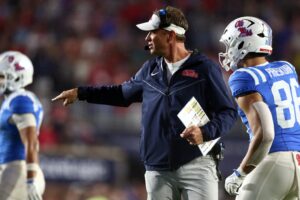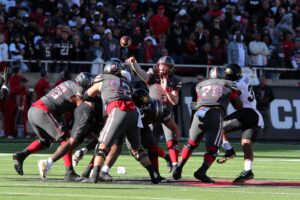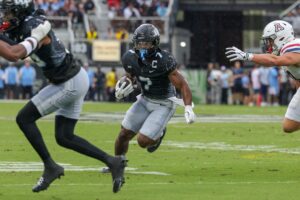Building the Mountaineers’ Future: Part One
After eight games, we have seen bits and pieces of the Mountaineers’ new identity under head coach Neal Brown. The proverbial climb, about which Brown regularly preaches, remains a work in progress. But Brown told us after the win over TCU, that the game put West Virginia football on full display. So we take a look at how Brown is building the Mountaineers’ future.
Blue Collar Football – The Run Game
We write regularly here about how Brown seeks to foster a blue collar mentality in Morgantown. He announced that to the wider college football world at his first Big 12 media days. Brown said he would focus on building a strong defense supplemented by a power run game. What does he want from that? The Mountaineers want, according to Brown, to line up and successfully run the football even “when everyone knows we are going to run.” Easy enough, right?
2019 Efforts
In Brown’s first season, he lost several experienced offensive linemen. Yodny Cajuste and Isaiah Hardy graduated. Matt Jones transferred to Youngstown State. Josh Sills suffered an early injury and then transferred. Jacob Buccigrossi retired from football. Thus, the Mountaineers returned only around 30% of their offensive line experience.
As a result, the run game produced the worst results in decades, averaging just 73 yards a game and just over two-and-a-half yards per carry. Before this season, Brown noted that the team’s rushing game would improve, but that the improvement would be incremental. By no means, Brown warned, had West Virginia “arrived” at their peak.
2020: Step One
But even with incremental change, the run game improved vastly this season. So far, through eight games, West Virginia averages 157 rushing yards per game on just over four yards per carry. If that’s simply an “incremental” improvement, it tells us a bit about Brown’s frame of reference. The team has more than doubled its rush yard output and has improved its efficiency by over 60%. But how?
Well, Leddie Brown has put the run game on his shoulders. After the coaches challenged him to improve his ability to run through and after contact, Brown did just that. Over half of his nearly 900 yards come after contact. For that effort, he averages five-and-a-half yards a carry and has nine rushing touchdowns. By comparison, the entire team managed just seven rushing touchdowns all of last season.
The offensive line also features a better balance of game-ready youth and experience. Two seniors–Chase Behrndt and Mike Brown–lead the unit. Two freshman–Zach Frazier (a true freshman) and Brandon Yates (a redshirt freshman)–earned their first college snaps. A junior, John Hughes, joins them. West Virginia also rotates two sophomores–Briason Mays and James Gmiter–in the unit. Their efforts are bolstered by returning tight ends and a group of receivers who have vastly improved their run-blocking efforts.
2021 And Beyond: Step Two
Surely, the Mountaineers’ second “increment” cannot be doubling production again. But the next level might look like a 200-yard average output and close to five yards per carry. How can they do that? Well, offensive line coach Matt Moore has good vision for recruiting and developing offensive linemen. But it is a task that takes time. For experienced players, you have to remove bad habits, and, for new players, you have to give them enough meaningful chances to fail, and learn.
West Virginia might lose Behrndt and Brown, though both could come back given the NCAA granting all players an extra year of eligibility. Of the two, we think Brown is most likely to return, given that he has not played much football, and better days are clearly ahead of him. As a result, the Mountaineers will feature an offensive line next season that rotates Brown (a super-senior), Hughes (a senior), Yates and Frazier (sophomores with full seasons of snaps), Mays and Gmiter (juniors with plenty of snaps), and a few newcomers.
Four-star offensive linemen Chris Mayo will certainly compete. As will four-star Virginia transfer Ja’Quay Hubbard. As will highly-coveted four-star freshman Wyatt Milum. Jordan White, Tairiq Stewart, Blaine Scott, and several others will also look to take the next step forward. Suddenly, a thin room becomes packed with a complement of highly-rated prospects and experienced veterans.
Running For The Future
And who will be running behind them? Leddie Brown is only a junior, but the smart money says he will enter the NFL draft. The shelf life on running backs remains small, and Brown has earned himself a spot on the third day of the draft, at least. He currently ranks third in the country in total rushing yards.
But the cupboards are not bare. Alec Sinkfield has proven to be a good change-of-pace back, particularly when he runs with focus. He still needs to develop consistency, but, on the days when he runs with patience and makes a single, well-timed cut before getting up to full speed, Sinkfield does plenty of damage.
Tony Mathis and A’Varius Sparrow will continue to develop as well. Neither has seen much playing time this season, but they will be counted on to take the next steps in their development this offseason. Coach Brown believes Mathis has a bright future. And, while we have not heard much about Sparrow this season, he flashed plenty of potential in his senior season. Sparrow, like Mike Brown, is a relative newcomer to the game. He may have a lot to learn going forward, but, if he takes to his coaching, he has a high ceiling.
Finally, the Mountaineers should add two coveted four-star running backs next season in Jaylen Anderson and Justin Johnson. Both have produced at high levels in their respective senior seasons, and one or both will have plenty of opportunity to step in and make immediate impacts. With the offensive line poised to take its next big leap forward next season, they have all the chance in the world to run with those opportunities and help build the Mountaineers’ future.






